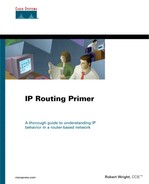Introduction to Terminology
Before proceeding any further in this chapter, it is important to lay the groundwork for the discussion by defining some terms, as follows:
A major net(work) refers to the network-only portion of an Internet address. In Figure 3-1, the major net of subnet 168.71.5.0 is 168.71.0.0 because Class B addresses use only the first two of the four bytes in an IP address to determine the network address space. The other two bytes can be used for host addresses or a combination of subnets and host addresses. In other words, the term major net is used for the bytes of an address that are reserved for the network portion, based on the class of address in use. The major net for address 10.9.0.0 is 10.0.0.0. The major net for address 223.221.142.8 with a mask of 255.255.255.248 is 223.221.142.0.
In a discontiguous network, IP subnet addresses from a major network are applied to physical networks that are separated by a network with a different major net. In Figure 3-1, the link between RouterA and RouterB has been configured with a different major network address (168.72.0.0).
To summarize means to report only the major net portion of an address, even though there are subnets of the address in the routing table. In Figure 3-1, RouterB has a network with subnet 168.71.8.0 assigned. When RouterB is preparing a routing update to send out serial 0, it will notice that serial 0 is part of a different major net and send out only the summarized (in this case, major net) portion of the address.
Aggregation is very similar to summarization. In fact, many people use the terms interchangeably. This book treats the terms as similar, but not identical, functions. In the context of this book, aggregation means reducing the number of subnets in a routing advertisement by advertising only the common portion of the subnet addresses that is required to provide full IP connectivity. If RouterA were connected to subnets 168.71.1.16, 168.71.1.32, and 168.71.1.48, and RouterB were connected to subnets 168.71.2.16, 168.71.2.32, and 168.71.2.48, each router could aggregate its connected subnets to the third byte. Full connectivity would be possible if RouterA advertised only 168.71.1.0 and RouterB advertised only 168.71.2.0. For a more detailed explanation, see the section on aggregation later in this chapter.
A major net boundary is a router connected to two or more major nets. In Figure 3-1, RouterA is connected to two major nets: 168.71.0.0 and 168.72.0.0. The routing update for 168.71.5.0 that would be advertised over serial 0 to RouterB is encountering a major net boundary—168.71.0.0 >> 168.72.0.0. RouterA will summarize the 168.71.5.0 route to the major net of 168.71.0.0.
Now that you are familiar with the terms used in this chapter, you can move on to the heart of the matter—starting with discontiguous networks.
